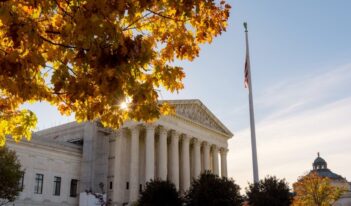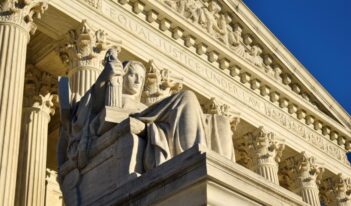
Electricity regulator wants strong incentive to conserve, but one business group says the government is overreaching.
The federal government wants to help consumers get paid to turn off their lights, but electricity producers say the policy goes too far and takes power from the states.
The Supreme Court recently heard oral arguments in FERC v. Electric Power Supply Association, a case challenging a U.S. Federal Energy Regulatory Commission (FERC) order encouraging electricity conservation. Representatives from the power supply industry argue that the order went beyond FERC’s legal authority and did not address their comments.
In 2011, the Commission issued an order requiring wholesale electricity markets to treat efforts to reduce energy demand the same as efforts to increase energy supply.
Electricity demand sometimes sharply increases above normal, such as on hot days when many people turn on their air conditioning. During these periods called “peak demand,” blackouts may occur unless power plants increase supply by creating more power or consumers reduce demand by using less electricity – or both.
A major blackout in 2003 prompted passage of the Energy Policy Act of 2005 to strengthen the electrical grid’s reliability. The Energy Policy Act amended the Federal Power Act, the 1920 law that created FERC and defined its jurisdiction. Part of the new law encouraged a practice known as “demand response.”
Demand response is the practice of consumers using less electricity in response to prices, emergencies, or incentives. It is a component of a modern “smart grid” system that utilities rely upon to manage supply and demand of electricity in real time. The “smart grid” is a set of practices and policies that use information technology to improve electricity supply.
Under the smart grid, some companies called “aggregators” are paid to encourage consumers to use less electricity in order to help bring supply and demand in balance and avoid a blackout without power plants increasing output. For example, an aggregator may contract with a utility and pay households to install remote-controlled thermostats that the aggregator adjusts during peak demand.
FERC’s 2011 order requires the price offered to an aggregator for reducing demand be the same as the price offered to a power plant for increasing supply. FERC reasoned that since increasing supply by one megawatt and reducing demand by one megawatt (sometimes called a “negawatt”) are equally effective at preventing blackouts, they should be the same price. The order only applies to sales made through two types of entities, Independent System Operators and Regional Transmission Organizations, which FERC designs and forms to administer wholesale electricity markets.
The Supreme Court case challenges whether the order was regulating electricity in the wholesale market or retail market. Both parties agree that FERC has authority under the Federal Power Act to issue orders to promote “just and reasonable rates” in the wholesale electricity market. The Electric Power Supply Association argues that the order amounts to paying consumers not to use electricity, and as such regulates retail sales, which is outside of FERC’s authority. The government argues that FERC’s order only sets out rules for prices on wholesale markets.
During oral argument before the Supreme Court, the justices appeared most concerned with the agency’s authority under the Federal Power Act. Justice Kennedy started the questioning by stating that each market necessarily affects the other, but then asked Solicitor General Donald Verrilli how to draw the line between what FERC can and cannot regulate. Justice Scalia suggested that the order sought to affect retail consumers’ decisions about energy usage. Justice Roberts expressed concern that the order regulates retail prices by creating an opportunity cost, and asked for a limiting principle the court could apply.
Solicitor Verrilli responded that the order only applies to entities organized as wholesale markets, and that the Court has upheld FERC authority before when the effects on retail prices were more apparent. He twice stressed that the Justices should use the so-called Chevron test and defer to the agency’s expertise in interpreting the Federal Power Act as allowing it to regulate prices in this manner.
Power suppliers’ counsel, Paul Clement, also argued that the order violated the Administrative Procedure Act (APA) and was arbitrary and capricious in terms of procedure and substance. However, the justice’s questions were more circumspect on this issue.
On the procedural issues, the power suppliers argued that FERC did not adequately respond to their comments arguing against the order, as required by the APA. Justice Sotomayor expressed belief that FERC addressed all of the critical comments, but Justice Scalia suggested dissatisfaction with one of FERC’s responses about how it would address economic inefficiencies. FERC responded that it would use a “net-benefits test” to determine if the order would create inefficiencies before applying it, which seemed to satisfy Justice Breyer on procedural grounds.
The Court spent more time parsing out the substantive APA challenge: whether the order was supported by economics. The power suppliers argued that the order was not supported by economic evidence, rendering it arbitrary and capricious. They rejected the notion that “negawatts” were functionally equivalent to megawatts of electricity, and claimed that the order would overpay consumers. Justice Kennedy implied that FERC’s economic arguments were circular because FERC argued that market forces would work things out while claiming authority to define the scope of the market. Justice Breyer promised to read more closely amicus briefs focused on economic issues to determine whether FERC’s net-benefits test substantively addressed the economic arguments of the power suppliers.
Only eight Supreme Court Justices heard the case, which may make reaching a majority opinion more difficult. Justice Alito recused himself, presumably because recent financial disclosures show that he owned stock in a company involved in the case.
If the Supreme Court splits 4-4 in this case, then the lower court’s decision invalidating the order will stand. The D.C. Circuit previously held 2-1 that FERC had encroached on the jurisdiction of the states to regulate the retail market, and alternatively that the order was arbitrary and capricious because FERC failed to respond to arguments. The Regulatory Review contributors argued earlier this year that the D.C. Circuit should be overturned.



